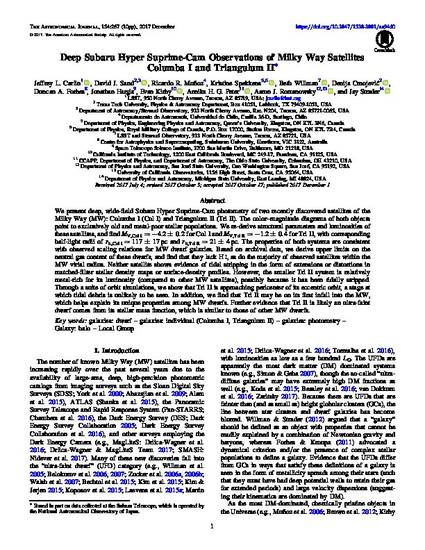
Article
Deep Subaru Hyper Suprime-Cam Observations of Milky Way Satellites Columba I and Triangulum II*
The Astronomical Journal
(2017)
Abstract
We present deep, wide-field Subaru Hyper Suprime-Cam photometry of two recently discovered satellites of the Milky Way (MW): Columba I (Col I) and Triangulum II (Tri II). The color–magnitude diagrams of both objects point to exclusively old and metal-poor stellar populations. We re-derive structural parameters and luminosities of these satellites, and find for Col I and for Tri II, with corresponding half-light radii of pc and pc. The properties of both systems are consistent with observed scaling relations for MW dwarf galaxies. Based on archival data, we derive upper limits on the neutral gas content of these dwarfs, and find that they lack H i, as do the majority of observed satellites within the MW virial radius. Neither satellite shows evidence of tidal stripping in the form of extensions or distortions in matched-filter stellar density maps or surface-density profiles. However, the smaller Tri II system is relatively metal-rich for its luminosity (compared to other MW satellites), possibly because it has been tidally stripped. Through a suite of orbit simulations, we show that Tri II is approaching pericenter of its eccentric orbit, a stage at which tidal debris is unlikely to be seen. In addition, we find that Tri II may be on its first infall into the MW, which helps explain its unique properties among MW dwarfs. Further evidence that Tri II is likely an ultra-faint dwarf comes from its stellar mass function, which is similar to those of other MW dwarfs.
Keywords
- galaxies: dwarf,
- galaxies: individual : Columba I,
- galaxies: individual : Triangulum II,
- galaxies: photometry,
- Galaxy: halo,
- Local Group
Disciplines
Publication Date
December 1, 2017
DOI
10.3847/1538-3881/aa94d0
Publisher Statement
This article was originally published in The Astronomical Journal, volume 154, issue 6. © 2017. The American Astronomical Society. All rights reserved.
This article is also available online at the following link: https://doi.org/10.3847/1538-3881/aa94d0
Citation Information
Jeffrey L. Carlin, David J. Sand, Ricardo R. Muñoz, Kristine Spekkens, et al.. "Deep Subaru Hyper Suprime-Cam Observations of Milky Way Satellites Columba I and Triangulum II*" The Astronomical Journal Vol. 154 Iss. 6 (2017) ISSN: 0004-6256 Available at: http://works.bepress.com/aaron_romanowsky/134/
